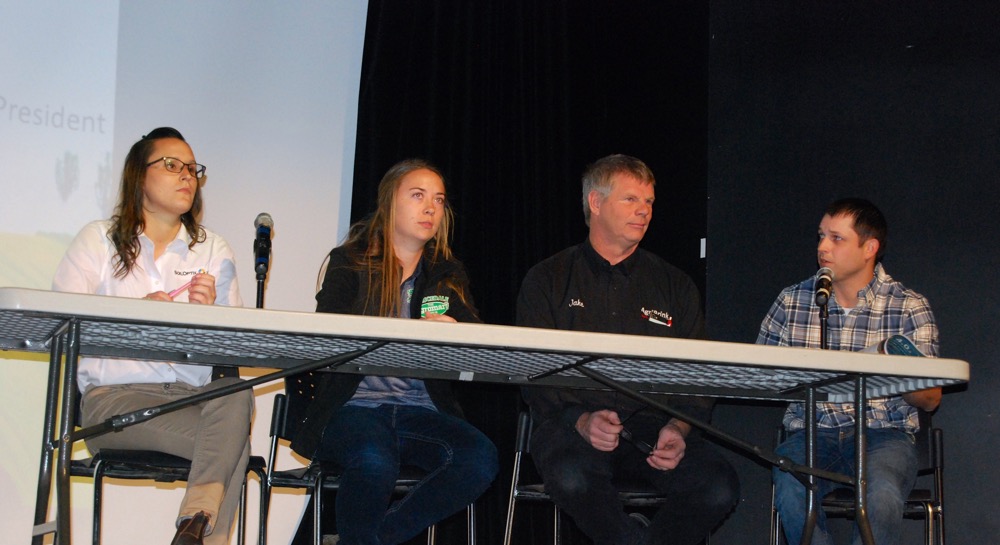Farmers have to make decisions on which soil-health technologies they want to adopt
By Lois Harris Published: November 22, 2018

Building and maintaining soil health increasingly involves technology. The challenge for farmers is deciding which approach they invest in to monitor and maintain their soil health.
Three different approaches using technology to solve soil health problems were presented at the Grey County’s third annual Ag 4.0.2 conference held Nov. 1, 2018 in Meaford.
Why it matters: Using the latest tools to keep soil healthy can result in higher yields and more sustainable and affordable crop production, as long as the technology makes sense from a business perspective.
Compaction is one of the major problems that needs to be tackled.
“Pioneer Hi-Bred has identified soil compaction as the number one yield robber for crops,” said Jake Kraayenbrink, owner of AgriBrink, a company that makes and sells centre tire inflation/deflation systems.
Compacted soil — the result of heavy equipment being used on the land — has less space available for root growth, water and air and is more vulnerable to wind and water erosion.
Kraayenbrink said that since the 1950s, farm machinery has gained 800 to 900 pounds per year, making the problem exponentially worse.
Deflating tires increases the surface area touching the ground, helps them ride over the top of the soil and reduces compaction. The tires have to be reinflated for road travel so they won’t be destroyed by wear.
While in the past, deflation/inflation technology hasn’t worked quickly enough, the latest systems have resolved that problem.
“It used to take several minutes to deflate a tire from 35 to 15 pounds. Now we can get it done in 20 seconds,” he said. “That was a huge breakthrough.”
He added that getting tire pressure down to at least 15 pounds per square inch (p.s.i.) is optimal for saving soil from compaction.
Better monitoring tools
“We believe that everything starts with the soil,” said Jordanna Kalis from SoilOptix, a company that specializes in digital high-definition top soil mapping.
SoilOptix makes a high-speed sensor that mounts on the front of tractors, Jeeps, trucks or ATVs and collects data from gamma rays that are emitted from the soil.
Running at 10 to 12 miles per hour in 40-foot swaths, data is collected every three to five feet, providing 335 data points for every acre in the field. Physical soil samples are also taken to calibrate the sensor readings.
Data collected from the field and the samples are then analyzed by GIS analysts and the resulting high-definition maps are extremely accurate.
They show everything from the macro- and micronutrients in the soil to its texture (percentage clay, sand and silt) as well as how much water is available to plants and its density. The maps can be used to better understand soil variability and make more informed decisions for seeding and fertilization.
The maps can be loaded into most crop management platforms, including Climate FieldView, which was announced recently.
Deeper precision systems
Another approach to managing soil health was presented by Taylor Vokes of Sprucedale Agromart. The company started offering a precision agriculture program called Agrian earlier this year, allowing them to do more targeted placement of fertilizer.
The web-based platform generates yield maps, satellite imagery, harvest maps and application maps. Vokes samples fields with the help of global positioning satellites. She takes her iPad with her to determine exact areas where samples need to be taken and can even put in nutrient recommendations as she goes.
A field file is barcoded and uploaded to the laboratory for analysis. Results from the lab are then used to generate a prescription map that includes desired crop yields and maximum and minimum rates of fertilizer to apply. The prescription map can then be loaded into any piece of equipment that’s capable of precision application and the fertilizer is applied on the field accordingly.
Maps can be overlaid to allow year-over-year comparisons so the analysis can show how well management practices such as fertilization and pest protection have worked.
“This allows us to make better decisions about where to place the fertilizer, targeting problem areas instead of blanket applying the entire field,” she said.
Source:

